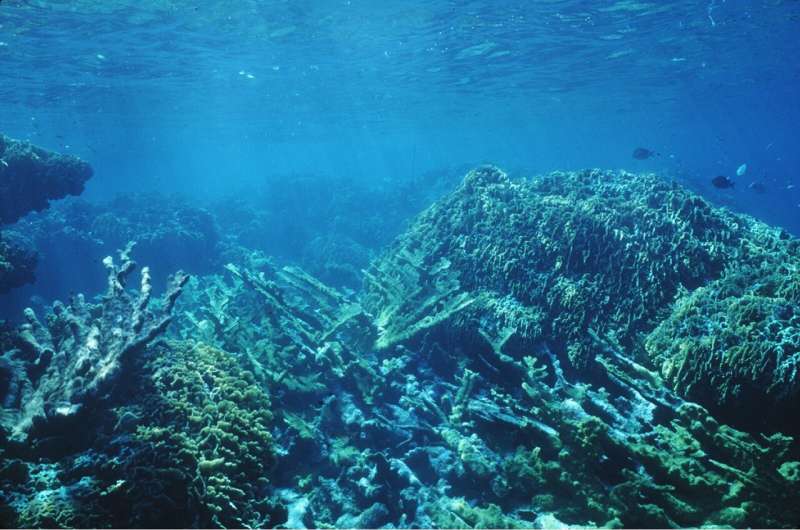This article has been reviewed according to Science X's editorial process and policies. Editors have highlighted the following attributes while ensuring the content's credibility:
fact-checked
peer-reviewed publication
trusted source
proofread
Growth of coral reefs likely cannot keep pace with rising sea level

Tropical coral reefs could end up being one of the first victims of climate change. The marine diversity hotspots are threatened and declining as a result of global warming, ocean acidification, a deterioration of water quality, as well as diseases of reef-building organisms, and their growth is unable to keep up with the projected rise in sea levels.
These are some of the conclusions drawn by an interdisciplinary team of scientists from Goethe University Frankfurt's Institute of Geosciences, the company ReefTech Inc., the GEOMAR Helmholtz Center of Ocean Research, the University of Ottawa's Department of Earth and Environmental Sciences, and the GSI Helmholtz Center of Heavy Ion Research.
Their findings, now published in Scientific Reports, are based on an examination of 22 drill cores collected from the Belize barrier reef and atolls, the largest reef system in the Atlantic Ocean. The research focused on identifying and dating coral growth and accretion rates over the past 9,000 years.
Professor Eberhard Gischler, head of the biosedimentology working group at Goethe University Frankfurt's Institute of Geosciences, and other scientists reexamined the specimens Gischler and Dr. J. Harold Hudson, Miami, U.S., had collected between 1995 and 2002 .
Studying the drill cores—which taken together measure a total of 215 meters—"enables us to develop both detailed and systematic reconstructions of the environmental conditions that prevailed during the Holocene, based on which previous ecological and environmental conditions can be reconstructed, allowing us to determine whether the current coral and coral reef declines are in fact unprecedented," Gischler says.
Pooling their expertise, they identified and dated 127 coral fragments using radioisotope methods, and statistically analyzed the changes in coral community structure over time based on more than 1,100 fossil corals. Radioisotope dating allows scientists to determine the age of a material by referring to the decay rates of radioactive samples present in the sample.
Having dated the corals, the team then identified the distances between them in the drill cores to estimate their growth rates. "Our data show that coral accretion rates in Belize decreased during the Holocene. While at 3.36 millimeters per year, the average accretion rates of reef margins are in the same range as other regions in the western Atlantic, they are somewhat lower than those in the Indo-Pacific."
This has both an important impact on the future of tropical island-nations especially, which are either based on or protected by coral reef structure, and is also interesting in the context of climate change, Gischler explains. "The growth rates are at the lower end of the United Nations' Intergovernmental Panel on Climate Change's (IPCC) predictions of future sea-level rise until 2100."
The research confirms the drastic decline in live coral in the Caribbean, where many reefs are no longer dominated by corals, but fleshy algae as well as weedy, generalistic taxa. Looking at the evolution over time, Gischler and his colleagues found that stress-tolerant, reef-building corals predominate in the older sections.
"At the base of our cores, directly overlying Pleistocene reef limestone, Pseudodiploria brain corals and Orbicella star corals are most common, illustrating that members of the stress-tolerant taxa are clearly dominating," Gischler explains. Once the reef pedestal was fully inundated and environmental conditions improved, however, the abundance of this type of coral decreased.
The study's authors point out that the shift from stony corals to fleshy algae and from common reef-builders to weedy taxa underlines the increasing importance of fecundity for the coral community, a trait which it seems helps them cope with increasing environmental stress.
Pre-Anthropocene gaps in growth
Another interesting detail unearthed in the drill cores is the existence of three centennial-scale gaps in the fossil record of the fast-growing, competitive "elkhorn coral" Acropora palmata in Belize—at about 2,000, 4,000, as well as 5,500–6,000 years before today.
The first and last of the gaps coincide with the two Acropora gaps in the Virgin Islands and the wider Caribbean, the researchers say, and likely point to periods of higher temperatures and increased storm activity as well as lower nutrient supply as possible causes.
By contrast, the gap around 4,000 years before today coincides with a potential mass mortality of grazing echinoids in the region, which might have caused an increase in the abundance of fleshy algae during this time window. Another possible cause advanced by the study's authors is that the mortality was connected to the so-called 4.2 k-event, thought to have resulted in mid-latitude drought in North America as well as elevated sea surface temperature in tropical oceans.
More information: Eberhard Gischler et al, 9000 years of change in coral community structure and accretion in Belize reefs, western Atlantic, Scientific Reports (2023). DOI: 10.1038/s41598-023-38118-5
Journal information: Scientific Reports
Provided by Goethe University Frankfurt am Main




















